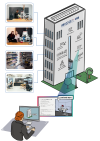| Both sides previous revisionPrevious revisionNext revision | Previous revisionNext revisionBoth sides next revision |
| research [2023/11/29 12:56] – cstoess | research [2024/01/23 09:14] – [Internal Research Projects] pmania |
|---|
| ^ {{:team:logo_eurobin193x54px.png?nolink&200|}} ^ **[[https://www.eurobin-project.eu//|euROBIN]]**: euROBIN is the Network of Excellence that brings together European expertise on Robotics and Artificial Intelligence (AI). It will establish a unified pan-European platform for research and development. For the first time, a large number of distinguished research labs across Europe are jointly researching AI-Based Robotics. As the lead beneficiary of the work package "Know", the Institute of Artificial Intelligence at the University of Bremen will provide, consolidate, combine, and advance the knowledge representation and reasoning (KR&R) capabilities of the euROBIN network. ^ | ^ {{:team:logo_eurobin193x54px.png?nolink&200|}} ^ **[[https://www.eurobin-project.eu//|euROBIN]]**: euROBIN is the Network of Excellence that brings together European expertise on Robotics and Artificial Intelligence (AI). It will establish a unified pan-European platform for research and development. For the first time, a large number of distinguished research labs across Europe are jointly researching AI-Based Robotics. As the lead beneficiary of the work package "Know", the Institute of Artificial Intelligence at the University of Bremen will provide, consolidate, combine, and advance the knowledge representation and reasoning (KR&R) capabilities of the euROBIN network. ^ |
| ^ [[https://intel4coro.ai.uni-bremen.de|{{:intel4coro_logo.png?200|}}]] ^**[[https://intel4coro.ai.uni-bremen.de|IntEL4CoRo]]**'s aim is to develop an immersive learning environment for Cognitive Robotics that holistically supports students and teachers.\\ Through an AI-based robot control system integrated in the learning environment, students will be able to interactively experience the course material and perform programming exercises with software components that can run on real robots: In this way, students will be able to grasp the cognitive robotics concepts taught in the courses in a hands-on way.\\ In addition to solving small programming problems, the learning environment will also enable the completion of bachelor's and master's theses, team-based software development projects and competitions.\\ The comprehensive development and simulation environment will be combined with innovative didactic concepts such as the AVIVA model, which allows students to determine the most appropriate learning path for their level of knowledge and skills through self-assessment tools. As an open educational resource, IntEL4CoRo will be accessible to students and teachers for open use.^ | ^ [[https://intel4coro.ai.uni-bremen.de|{{:intel4coro_logo.png?200|}}]] ^**[[https://intel4coro.ai.uni-bremen.de|IntEL4CoRo]]**'s aim is to develop an immersive learning environment for Cognitive Robotics that holistically supports students and teachers.\\ Through an AI-based robot control system integrated in the learning environment, students will be able to interactively experience the course material and perform programming exercises with software components that can run on real robots: In this way, students will be able to grasp the cognitive robotics concepts taught in the courses in a hands-on way.\\ In addition to solving small programming problems, the learning environment will also enable the completion of bachelor's and master's theses, team-based software development projects and competitions.\\ The comprehensive development and simulation environment will be combined with innovative didactic concepts such as the AVIVA model, which allows students to determine the most appropriate learning path for their level of knowledge and skills through self-assessment tools. As an open educational resource, IntEL4CoRo will be accessible to students and teachers for open use.^ |
| ^ {{:tmp:ai4hri_logo.png?nolink&200|}} ^ **AI4HRI** (Artificial Intelligence for Human-Robot Interaction): Europe and Japan both face problems of shrinking and aging population, and using social robots is seen as a possible way of alleviating demographic issues. Robots need to be able to interact with people and this is studied in the field of Human-Robot Interaction (HRI). But dealing with humans is difficult, and HRI is still not making enough use of AI technologies. The goal of the AI4HRI project is to both develop and integrate several AI methods which will allow social robots to appropriately deal with humans around them. This includes 3 abilities that are currently missing in HRI: knowledge management and reasoning, learning of social skills, and planning and executing joint human-robot actions. AI4HRI brings together three teams who have very complementary approaches to solving the issues addressed by the project. IAI has extensive expertise on knowledge management and reasoning, Kyoto University, Japan has large know-how in learning for social interactions, and LAAS-CNRS, France adds to that strong expertise in human-aware design and in joint action planning and execution. The project will benefit from their synergy. Importantly, the above abilities will be combined into a single open-source architecture and shared with other researchers. ^ | ^ {{:tmp:ai4hri_logo.png?nolink&200|}} ^**[[https://sites.laas.fr/projects/ai4hri/|AI4HRI]]** (Artificial Intelligence for Human-Robot Interaction): Europe and Japan both face problems of shrinking and aging population, and using social robots is seen as a possible way of alleviating demographic issues. Robots need to be able to interact with people and this is studied in the field of Human-Robot Interaction (HRI). But dealing with humans is difficult, and HRI is still not making enough use of AI technologies. The goal of the AI4HRI project is to both develop and integrate several AI methods which will allow social robots to appropriately deal with humans around them. This includes 3 abilities that are currently missing in HRI: knowledge management and reasoning, learning of social skills, and planning and executing joint human-robot actions. AI4HRI brings together three teams who have very complementary approaches to solving the issues addressed by the project. IAI has extensive expertise on knowledge management and reasoning, Kyoto University, Japan has large know-how in learning for social interactions, and LAAS-CNRS, France adds to that strong expertise in human-aware design and in joint action planning and execution. The project will benefit from their synergy. Importantly, the above abilities will be combined into a single open-source architecture and shared with other researchers. ^ |
| ^ {{:team:tracebot_logo_2021_rgb.png?nolink&200|}} ^ **TraceBot** (Traceable Robotic Handling of Sterile Medical Products): The TraceBot project, supported by the European Union's H2020-EU.2.1.1 program, is an initiative aimed at enhancing robotic capabilities in healthcare and laboratory environments through technological innovation. The project's primary objective is to develop robotic systems capable of executing verifiable actions within a traceability framework, supported by knowledge-based digital-twin technology. This approach allows for tracking and validation of robotic actions, crucial in processes such as the production and sterility testing of medical products. By incorporating these advanced robotic solutions, TraceBot contributes to increasing precision, safety, and operational efficiency in medical and laboratory settings. ^ | ^ {{:team:tracebot_logo_2021_rgb.png?nolink&200|}} ^**[[https://www.biolago.org/en/projects/details/tracebot.html|TraceBot]]** (Traceable Robotic Handling of Sterile Medical Products): The TraceBot project, supported by the European Union's H2020-EU.2.1.1 program, is an initiative aimed at enhancing robotic capabilities in healthcare and laboratory environments through technological innovation. The project's primary objective is to develop robotic systems capable of executing verifiable actions within a traceability framework, supported by knowledge-based digital-twin technology. This approach allows for tracking and validation of robotic actions, crucial in processes such as the production and sterility testing of medical products. By incorporating these advanced robotic solutions, TraceBot contributes to increasing precision, safety, and operational efficiency in medical and laboratory settings. ^ |
| ^ {{:logo-ease-2019.png?nolink&200|}} ^**[[http://www.ease-crc.org|EASE]]** (SFB 1320) is a collaborative research center. EASE will investigate the design, realization, and analysis of information processing models that enable robotic agents (and humans) to master complex human-scale manipulation tasks that are mundane and routine. EASE not only investigates action selection and control but also the methods needed to acquire the knowledge, skills, and competence required for flexible, reliable, and efficient mastery of these activities.^ | ^ {{:logo-ease-2019.png?nolink&200|}} ^**[[http://www.ease-crc.org|EASE]]** (SFB 1320) is a collaborative research center. EASE will investigate the design, realization, and analysis of information processing models that enable robotic agents (and humans) to master complex human-scale manipulation tasks that are mundane and routine. EASE not only investigates action selection and control but also the methods needed to acquire the knowledge, skills, and competence required for flexible, reliable, and efficient mastery of these activities.^ |
| ^ {{:projects:remaro.png?nolink&200|}} ^The **[[https://remaro.eu/|REMARO]]** project addresses the challenge of the development of a reliable AI system that can act on new underwater activities. The goal is to design brains for robots that enable robots to act safely while allowing them to improve by self-learning. Three project partners are from Bremen: DFKI, ROSEN Group, and the Institute of Artificial Intelligence at the University of Bremen.^ | ^ {{:projects:remaro.png?nolink&200|}} ^The **[[https://remaro.eu/|REMARO]]** project addresses the challenge of the development of a reliable AI system that can act on new underwater activities. The goal is to design brains for robots that enable robots to act safely while allowing them to improve by self-learning. Three project partners are from Bremen: DFKI, ROSEN Group, and the Institute of Artificial Intelligence at the University of Bremen.^ |
| ^ {{:research:sherpa.png?nolink&200}} ^**[[research:sherpa]]** develops a mixed autonomous ground and aerial robotic platform for support in search and rescue^ | ^ {{:research:sherpa.png?nolink&200}} ^**[[research:sherpa]]** develops a mixed autonomous ground and aerial robotic platform for support in search and rescue^ |
| ^ {{:projects:acat.png?nolink&200}} ^ **[[research:acat]]** enables robots to use information sources made for humans by learning and executing Action Categories^ | ^ {{:projects:acat.png?nolink&200}} ^ **[[research:acat]]** enables robots to use information sources made for humans by learning and executing Action Categories^ |
| ^ {{:rs_logo_text.png?nolink&200}} ^ **[[http://www.robosherlock.org|RoboSherlock]]** poses perception as a question-and-answer problem and uses the unstructured information management paradigm to create a framework for the perception of everyday objects^ | ^ {{:rs_logo_text.png?nolink&200}} ^ **[[https://pr2-looking-at-things.com/|RoboSherlock]]** poses perception as a question-and-answer problem and uses the unstructured information management paradigm to create a framework for the perception of everyday objects^ |
| ^ {{:projects:baycogrob.png?nolink&200}} ^ **[[research:BayCogRob]]** - Autonomous learning for Bayesian cognitive robotics (DFG Priority Program on Autonomous Learning)^ | ^ {{:projects:baycogrob.png?nolink&200}} ^ **[[research:BayCogRob]]** - Autonomous learning for Bayesian cognitive robotics (DFG Priority Program on Autonomous Learning)^ |
| ^ {{:projects:memoman.png?nolink&200}} ^ **[[research:MeMoMan2]]** investigates methods for real-time accurate model-based measurement of human motion^ | ^ {{:projects:memoman.png?nolink&200}} ^ **[[research:MeMoMan2]]** investigates methods for real-time accurate model-based measurement of human motion^ |
| ^ {{:projects:knowrob.png?nolink&200}} ^ **[[:research:knowrob]]**: Knowledge processing for autonomous robots^ | ^ {{:projects:knowrob.png?nolink&200}} ^ **[[:research:knowrob]]**: Knowledge processing for autonomous robots^ |
| ^ {{:research:software:pracmln-darkonbright-transp.png?nolink&200}} ^ **[[https://www.pracmln.org/|pracmln]]**: Markov logic networks in Python^ | ^ {{:research:software:pracmln-darkonbright-transp.png?nolink&200}} ^ **[[https://www.pracmln.org/|pracmln]]**: Markov logic networks in Python^ |
| ^ {{:research:software:prac-darkonbright-transp.png?nolink&200}} ^ **[[http://www.actioncores.org/|PRAC]]**: Probabilistic Action Cores -- Natural-language understanding for intelligent robots^ | ^ {{:research:software:prac-darkonbright-transp.png?nolink&200}} ^ **[[https://www.pracmln.org/|PRAC]]**: Probabilistic Action Cores -- Natural-language understanding for intelligent robots^ |
| ^ {{:projects:physics.png?nolink&200}} ^ **[[:research:naive-physics]]**: Simulation-based reasoning about physical effects^ | ^ {{:projects:physics.png?nolink&200}} ^ **[[:research:naive-physics]]**: Simulation-based reasoning about physical effects^ |
| |












